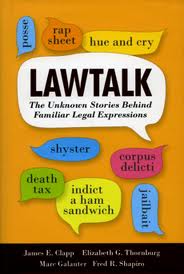 by James E. Clapp, Elizabeth G. Thornburg, Marc Galanter, and Fred R. Shapiro. Yale University Press, 2011, 348pp. Hardcover. $45.00. ISBN: 9780300172461.
by James E. Clapp, Elizabeth G. Thornburg, Marc Galanter, and Fred R. Shapiro. Yale University Press, 2011, 348pp. Hardcover. $45.00. ISBN: 9780300172461.Reviewed by Victoria A. Redd, The Journal Offices, University of Florida Levin College of Law, Email: reddva [at] Alaw.ufl.edu.
pp.122-123
In every profession, there is certain terminology that is used (a language that others may not understand), and the legal profession is no different: Legalese as some might call it can be difficult for the laymen to understand.
The words legalese, lawspeak, or lawtalk may cause some to turn away because it is an unlikely topic of discussion. Law scholars will enjoy the nuances and history behind the many legal terms used today. Even a layman, interested in the law, may find the history of today’s legal terms dating back some as far as 321 C.E. quite interesting. Why do the legal terms used even make sense today when their origin is from so long ago?
Because of the Internet age, the definition of terms can be researched far better than anyone thought possible leading to an exhaustive knowledge. With so much, however, it becomes necessary to pick through the information – to find what is useful legal terminology, what is current legal terminology, and what legal terminology “meets the needs . . . of [our] evolving society” (p.xi.).
Interestingly enough, there are so many legal terms that are interspersed in our everyday language: For example, the term “rule of thumb” which means “a rough but practical principle or guideline based on experience” (p.219). A “billable hour” is another term with a varied background. The fact that lawyers have not always billed by the hour, many times instead described as “for services rendered.” The lawyer’s public image in society has been one of an “economic predator, billing more hours than there are in a day.” Sound familiar?
Some other interesting terms used today are the “one-bite rule,” (p.165) “hearsay,” (p.121) and “fishing expedition.” (p.106). Perhaps the most unusual legal term used today, relatively speaking of course, would be “star chamber.” (p.242). This term, whose history comes from England’s medieval times refers to someone asking the King’s help in dealing with a very powerful individual. This term today refers to as “John Paul Stevens stated . . .Unconstrained executive detention for the purpose of investigating and preventing subversive activity. ” The opposite of “Day in court” (considered a fundamental right) (p.80), star chamber is used today in reference to an organization’s proceedings (such as that of a secretive governmental spy agency), that accuses someone of terrorism and basically imprisons them without a trial for an indefinite period of time (p.250). Others may disagree, opting for the word “testify” (p.250), whose actual history [*123] emanates from a Roman custom where a man gave an oath in court while holding his private parts. This accents the fact that many legal terms used today have some form of sexual connotation in the history of legal language. How precisely did the term “abuse excuse” begin? (p.1). What about the many irrelevant “blue laws” that remain on the books today regarding morality and behavior? (p.43). What is the origin of the term “comstockery”? (p.64)
Anyone who can use another legal reference book for their office or home library should consider James E. Clapp, Elizabeth G. Thornburg, Marc Glanter, and Fred R. Shapiro’s book, Lawtalk: The Unknown Stories Behind Familiar Legal Expressions. The book, part of the Yale Law Library Series in Legal History and Reference and funded by a foundation established in memory of Philip Hamilton McMillan of the Class of 1894 at Yale College, has been named appropriately, because it is a dictionary that deals with legal phrases and terms. Clapp, who is also the author of Random House Webster’s Dictionary of the Law, and company have managed to put together a book that is well-researched and educational. At the same time, it is entertaining, using stories, photos, jokes, illustrations, and even satirical cartoons. This book can be addicting and would also make a great edition to your law office or law school waiting room, or anywhere people who are interested in the law gather. I personally used it in my area and found that it was a crowd pleaser at least with law students.
Although, Lawtalk was advertised as “Not just for lawyers . . . ,” I’m not sure that the book would be interesting without the fascination of language, or at least the legal field. This reference book also promises to be “lively and unexpected,” – quoting the book’s cover – something that clearly is due to the various jokes and sidebars throughout the book, because there are only 77 legal terms defined total.
Lawtalk is organized alphabetically, has a table of contents, notes section, and an index. For those who have the love of the law, history, or legalese, this book is an easy sell. A companion book to this one, would be Lowering the Bar: Lawyer Jokes and Legal Culture by co-author Marc Galanter, where much of the material for the jokes came from. Law scholars and law students who want a browsable book to use when writing or perhaps for classroom banter should give Lawtalk a try – you may find that it’s well worth a laugh.
REFERENCE:
Galanter, Marc. 2006. Lowering the Bar: Lawyer Jokes and Legal Culture. Madison: Universirty of Wisconsin Press.
Copyright 2013 by the Author, Victoria A. Redd.